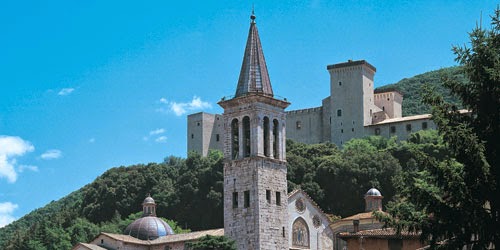 |
| The beautiful, striped Duomo di Siena. |
A Day in Siena (and a Spoleto Palio)
This past Saturday we traveled to Siena. The two sites that the students toured as a group were the Duomo, Santa Maria Assunta, and the government building, Palazzo Pubblico. These sites accentuated the secular and sacred balance that permeated the Sienese Republic in the Renaissance. Throughout the week the Arts and Architecture and Arts and Ideas classes discussed the importance of this city in the early Renaissance throughout the week.
The Duomo in Sienna boasts work by Donatello, Michelangelo, Pisano, and Pinturicchio, among others. The students were familiar with these artists through their recent work in the above mentioned classes. Mary Beth Immediatta, Arts and Ideas teacher, wrote the following about the students' work this week:
Our second week in Spoleto was a busy one for students in Art and Ideas as students continued to refine their aesthetic sensibility, began reading selections from Dante Alighieri’s masterwork and continued to apply a philosophical aesthetic, and historical lens to the towns to which they travelled.
On Monday the Art and Ideas class met in San Domenico, a church around the corner from the school. A copy of Raphael’s last work, The Transfiguration which hangs on a side wall, provided students with an opportunity to discuss aesthetic elements of a work initially completed by one of the great artists of the Italian Renaissance. As students discussed the work from perspectives of both form and content, they were unfazed by the stature of the original painter and offered their evaluations, commenting on many of the same disparate elements that have been identified by and have caused such disagreement among art critics for the last several centuries.
Just as students were gaining a new found confidence in their ability to render aesthetic judgment, at the midway point of their time in Italy, the course focus shifted somewhat as they began a new journey, accompanying Dante the pilgrim on the journey he undertook in the middle of his life, a journey recorded by Dante the poet from exile. For the remainder of their time in Art and Ideas, students will explore various Cantos from Commedia, examining the architecture of hell, suggesting alternate 21st century orderings of evil and remaining attentive to the sights, sounds, smells presented by Dante the pilgrim and Dante the poet, using the same sensory approaches with this great masterwork that they have applied using town as text throughout their course of study.
 |
| Palazzo Pubblico (public palace) that sits on the Piazza del Campo in Siena. |
The Arts and Architecture class focused on the structures in Siena. The central square, the Piazza del Campo, was constructed by the leaders of the Republic - the Nove - in the early Renaissance. The Palazzo Pubblico served as the home and office of these nine leaders. Beautiful frescoes by Simone Martini and the Lorenzetti brothers still adorn the walls of this building. Alison and Whitney explained the importance of these works of art to the students within the Palazzo.
 |
| The far end of the Piazza del Campo. Fellow, Rush, stands in the center. |
On Friday, the Contrade of Siena were explained to the students. The city was (and still is) divided into seventeen districts, Contrade. Every year these groups participate in a no-holds-barred horse race in the Piazza del Campo. On Friday, the students were divided up into ten Contrade themselves for a weekend competition (a Spoleto Palio). The festivities kicked off in Siena as the Contrade found their respective districts within the city, snapped selfless, purchased colorful flags, and prepared for the evening's race (palio).
 |
| The istrice (hedgehogs) pose in front of the Palazzo Pubblico. |
 |
| The whole group (with some contrade flags) pose in front of the Palazzo. |
 |
| Annie, of the chiocciola (snail) contrada. |


No comments:
Post a Comment